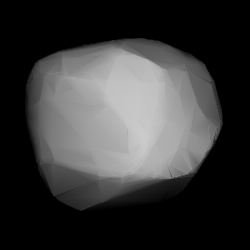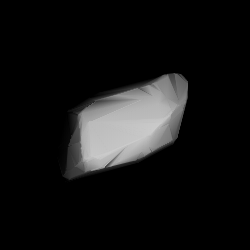
Lumen is a carbonaceous asteroid from the intermediate asteroid belt, approximately 130 kilometers in diameter. It is an identified Eunomian interloper.
2934 Aristophanes, provisional designation 4006 P-L, is a carbonaceous Veritasian asteroid from the outer regions of the asteroid belt, approximately 22 kilometers in diameter. It was discovered during the Palomar–Leiden survey in 1960, and later named after ancient Greek dramatist Aristophanes.

Hekate is a large main-belt asteroid.

Hecuba is a fairly large and bright main-belt asteroid. It was discovered by Karl Theodor Robert Luther on 2 April 1869, and named after Hecuba, wife of King Priam in the legends of the Trojan War in Greek Mythology. This object is orbiting the Sun with a period of 5.83 years and an eccentricity of 0.06. It became the first asteroid discovered to orbit near a 2:1 mean-motion resonance with the planet Jupiter, and is the namesake of the Hecuba group of asteroids.

Aemilia is a large main-belt asteroid. Aemilia was discovered by the French brothers Paul Henry and Prosper Henry on January 26, 1876. The credit for this discovery was given to Paul. It is probably named after the Via Aemilia, a Roman road in Italy that runs from Piacenza to Rimini.

Sita is a background asteroid from the inner region of the asteroid belt, approximately 11 kilometers in diameter. It was discovered on 14 October 1884, by an Austrian astronomer Johann Palisa in the Vienna Observatory. It was named for the Hindu deity Sita.

Tyche is a relatively large main belt asteroid discovered by Robert Luther at Düsseldorf-Bilk Observatory on 4 May 1886. The stony S-type asteroid measures about 65 kilometers in diameter and has a perihelion of 2.1 AU.

Lucretia is an asteroid belonging to the Flora family in the Main Belt. It was discovered by Austrian astronomer Johann Palisa on 31 October 1888 in Vienna, and is named after the middle name of Caroline Herschel, one of the first female astronomers. Light curves of this asteroid show a synodic rotation period of 4.349±0.001 h with an amplitude of 0.3–0.4 magnitude. The spin axis appears nearly perpendicular to the ecliptic.

Alice is a stony background asteroid from the inner region of the asteroid belt. It was discovered by Johann Palisa on 25 April 1890 at the Vienna Observatory.

California is an asteroid belonging to the Flora family in the Main Belt. It was discovered by Max Wolf on 25 September 1892 in Heidelberg, and is named for the U.S. state of California. This object is orbiting the Sun at a distance of 2.20 AU with a period of 3.26 yr and an eccentricity (ovalness) of 0.19. The orbital plane is inclined at an angle of 5.7° to the plane of the ecliptic.

Gisela is an asteroid belonging to the Flora family in the Main Belt that has an unusually high albedo.

Alma is an asteroid from the intermediate asteroid belt, approximately 24 kilometers in diameter. It was Guillaume Bigourdan's only asteroid discovery. He discovered it on 24 March 1894 in Paris.
Thia is a very large main-belt asteroid. It is classified as a C-type asteroid and is probably composed of carbonaceous material. This object was discovered by Auguste Charlois on July 23, 1895, in Nice, and was named after Theia, a Titaness in Greek mythology.
Friederike is a minor planet orbiting in the asteroid belt. It is a member of the Hygiea family of asteroids.
630 Euphemia is a mid-sized Eunomian asteroid.
633 Zelima is a minor planet orbiting the Sun in the asteroid belt with a magnitude of 10.7. The name may have been inspired by the asteroid's provisional designation 1907 ZM.
743 Eugenisis is a minor planet orbiting the Sun that was discovered by German astronomer Franz Kaiser in 1913.
78431 Kemble (provisional designation 2002 QJ50) is a background asteroid from the inner regions of the asteroid belt, approximately 1.4 kilometers (0.9 miles) in diameter. It was named after Father Lucian Kemble. The asteroid was discovered on 16 August 2002, by astronomer Andrew Lowe on images taken at the Palomar Observatory, California, United States.
8373 Stephengould is an outer main-belt binary asteroid discovered on 1 January 1992 by Carolyn S. Shoemaker and Eugene Merle Shoemaker at Palomar Observatory. The asteroid was named after the Harvard paleontologist Stephen Jay Gould. The asteroid has a very high inclination, having the second highest inclination of any of the first 10,000 discovered asteroids in the asteroid belt, after 2938 Hopi.
1861 Komenský, provisional designation 1970 WB, is an Eoan asteroid from the outer region of the asteroid belt, estimated to measure approximately 15 kilometers in diameter. It was discovered on 24 November 1970, by Czech astronomer Luboš Kohoutek at the Bergedorf Observatory in Hamburg, Germany, and named after John Amos Comenius.











